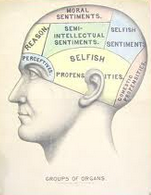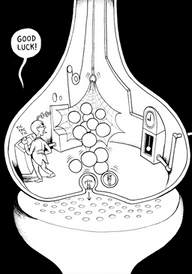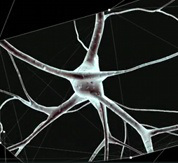Tom Stafford's Blog, page 55
March 7, 2013
The uncertain dance of the spoken word
 Stanford Magazine has a wonderful article by a writer who relies on lip-reading and experiences speech through this subtle movement-based language.
Stanford Magazine has a wonderful article by a writer who relies on lip-reading and experiences speech through this subtle movement-based language.
Rachel Kolb skilfully describes how this works, and more importantly, feels.
The part where she describes how she experiences accents is just amazing:
Accents are a visible tang on people’s lips. Witnessing someone with an accent is like taking a sip of clear water only to find it tainted with something else. I startle and leap to attention. As I explore the strange taste, my brain puzzles itself trying to pinpoint exactly what it is and how I should respond. I dive into the unfamiliar contortions of the lips, trying to push my way to some intelligible meaning. Accented words pull against the gravity of my experience; like slime-glossed fish, they wriggle and leap out of my hands. Staring down at my fingers’ muddy residue, my only choice is to shrug and cast out my line again.
The full article is highly recommended. Both fascinating and wonderfully written.
Link to ‘Seeing at the Speed of Sound’ (via and thanks to @stevesilberman)


March 5, 2013
The essence of intelligence is feedback
Here’s last week’s BBC Future column. The original is here, where it was called “Why our brains love feedback”. I was inspired to write it by a meeting with artist Tim Lewis, which happened as part of a project I’m involved with : Furnace Park, which is seeing a piece of reclaimed land in an old industrial area of Sheffield transformed into a public space by the University.
A meeting with an artist gets Tom Stafford thinking about the essence of intelligence. Our ability to grasp, process and respond to information about the world allows us follow a purpose. In some ways, it’s what makes us, us.
In Tim Lewis’s world, bizarre kinetic sculptures move, flap wings, draw and even walk around. The British artist creates mechanical animals and animal machines – like Pony, a robotic ostrich with an arm for a neck and a poised hand for a head – that creak into life in a way that can seem unsettling, as if they have a strange, if awkward, life of their own. His latest creations are able to respond to the environment, and it makes me ponder the essence of intelligence – in some ways revealing what makes us, us.
I met Tim on a cold Friday afternoon to talk about his work, and while talking about the cogs and gears he uses to make his artwork move, he made a remark that made me stop in my tracks. The funny thing is, he said, all of the technology existed to make machines like this in the sixteenth century – the thing that stopped them wasn’t the technical know-how, it was because they lacked the right model of the mind.
 Jetsam 2012, by Tim Lewis (Courtesy: Tim Lewis)
Jetsam 2012, by Tim Lewis (Courtesy: Tim Lewis)
What model of the mind do you need to create a device like Tim’s Jetsam, a large wire mesh Kiwi-like creature that forages around its cage for pieces of a nest to build. The intelligence in this creation isn’t in the precision of the craftwork (although it is precise), or in the faithfulness to the kind of movements seen in nature (although it is faithful). The intelligence is in how it responds to the placing of the sticks. It isn’t programmed in advance, it identifies where each piece is and where it needs to go.
This gives Jetsam the hallmark of intelligence – flexibility. If the environment changes, say when the sticks are re-scattered at random, it can still adapt and find the materials to build its nest. Rather than a brain giving instructions such as “Do this”, feedback allows instructions such as “If this, do that; if that, do the other”. Crucially, feedback allows a machine to follow a purpose – if the goal changes, the machine can adapt.
It’s this quality that the sixteenth century clockwork models lacked, and one that we as humans almost take for granted. We grasp and process information about the world in many forms, including sights, smells or sounds. We may give these information sources different names, but in some sense, these are essentially the same stuff.
Information control
Cybernetics is the name given to the study of feedback, and systems that use feedback, in all their forms. The term comes from the Greek word for “to steer”, and inspiration for some of the early work on cybernetics sprang from automatic guiding systems developed during World War II for guns or radar antennae. Around the middle of the twentieth century cybernetics became an intellectual movement across many different disciplines. It created a common language that allowed engineers to talk with psychologists, or ecologists to talk to mathematicians, about living organisms from the viewpoint of information control systems.
A key message of cybernetics is that you can’t control something unless you have feedback – and that means measurement of the outcomes. You can’t hit a moving target unless you get feedback on changes to its movement, just as you can’t tell if a drug is a cure unless you get feedback on how many more people recover when they are given it. The flip side of this dictum is the promise that with feedback, you can control anything. The human brain seems to be the arch embodiment of this cybernetic principle. With the right feedback, individuals have been known to control things as unlikely as their own heart rate, or learn to shrink and expand their pupils at will. It even seems possible to control the firing of individual brain cells.
But enhanced feedback methods can accelerate learning about more mundane behaviours. For example, if you are learning to take basketball shots, augmented feedback in the form of “You were 3 inches off to the left” can help you learn faster and reach a higher skill level quicker. Perhaps the most powerful example of an augmented feedback loop is the development of writing, which allowed us to take language and experiences, and make them permanent, solidifying it against the ravages of time, space and memory.
Thanks to feedback we can become more than simple programs with simple reflexes, and develop more complex responses to the environment. Feedback allows animals like us to follow a purpose. Tim Lewis’s mechanical bird might seem simple, but in terms of intelligence it has more in common with us than with nearly all other machines that humans have built. Engines or clocks might be incredibly sophisticated, but until they are able to gather their own data about the environment they remain trapped in fixed patterns.
Feedback loops, on the other hand, beginning with the senses but extending out across time and many individuals, allow us to self-construct, letting us travel to places we don’t have the instructions for beforehand, and letting us build on the history of our actions. In this way humanity pulls itself up by its own bootstraps.


March 3, 2013
The rise of everyday neuroscience
 I’ve got a feature article in The Observer about how our culture has become saturated with ‘neuroscience talk’ and how this has led to unhelpful simplifications of the brain to make the same old arguments.
I’ve got a feature article in The Observer about how our culture has become saturated with ‘neuroscience talk’ and how this has led to unhelpful simplifications of the brain to make the same old arguments.
This is often framed as a problem with ‘the media’ but this is just the most obvious aspect of the movement. Actually, it is a cultural change where the use of a sort of everyday ‘folk neuroscience’ has become credible in popular debate – regardless of its relationship to actual science.
Folk neuroscience comes with the additional benefit that it relies on concepts that are not easily challenged with subjective experience. When someone says “James is depressed because he can’t find a job”, this may be dismissed by personal experience, perhaps by mentioning a friend who was unemployed but didn’t get depressed. When someone says that “James is depressed because of a chemical imbalance in his brain”, personal experience is no longer relevant and the claim feels as if it is backed up by the authority of science. Neither usefully accounts for the complex ways in which our social world and neurobiology affect our mood but in non-specialist debate that rarely matters. As politicians have discovered it’s the force of your argument that matters and in rhetorical terms, neuroscience is a force-multiplier, even when it’s misfiring.
The article discusses how this popular neuroscience talk is being used and why is remains popular.
The piece was influenced by the work of sociologist Nikolas Rose who has written a great deal about how neuroscience is used to understand and manage people.
If you want to go in further depth than The Observer article allows I’d recommend his paper ‘Neurochemical Selves’ which is available online as a pdf.
A new book of his came out last week entitled ‘Neuro: The New Brain Sciences and the Management of the Mind’ which looks fascinating.
Link to Observer article ‘Our brains, and how they’re not as simple as we think’.


2013-03-01 Spike activity
Quick links from the past week in mind and brain news:

Providentia overs the curious history of Japan’s suicide volcano.
Skepticism about ‘social priming’ is driven by a long-history of doubt about subliminal priming of behaviour. Good piece on Daniel Simons’ Blog.
The New York Times has an amazing video about technology to enhance the perception of motion.
The ‘Vaccine Resistance Movement’ has an anti-vaccination conference in Vancouver on March 12th. Bizarrely it is being hosted by Simon Fraser University. If you want to contact them and make your views known you can do so here.
Neurobonkers covers a genuine scientific study on what gains Twitter followers. Note to self: posting pictures of yourself in underwear only works if you’re a glamour model.
We’re all Jonah Lehrer except me. Neuroskeptic on narrative and neuroscience.
The Fix discusses the overuse of ‘addiction’ to describe bad choices.
UK public art and neuroscience events currenty running: Affecting Perception taking place in Oxford and Wonder happening in London.
Slate has a form from 1889 to leave your brain to science. Only brains of “educated and orderly persons rather than those of the ignorant, criminal or insane”!
London neuroscience centre to map ‘connectome‘ of foetal brain reports Wired UK.


March 2, 2013
A neurobiological graphic novel
 The Guardian has a video about the collaboration between neuroscientist Hana Ros and artist Matteo Farinella as they’ve been working on the neurocomic project to create a brain science graphic novel.
The Guardian has a video about the collaboration between neuroscientist Hana Ros and artist Matteo Farinella as they’ve been working on the neurocomic project to create a brain science graphic novel.
The finished project isn’t quite out yet but the artwork is looking amazing.
The film about the collaboration covers how they worked together and how each approach their work.
There’s a lovely bit where Hana Ros describes how she isolates neurons to work on and mentions she gives them all names.
Make sure you also check out the artwork on the project website.
Link to video on the collaboration.
Link to the neurocomic website.


February 28, 2013
A fine art
 It’s not often you get to enrage both feminists and misogynists at the same time but a new study, just published in the Archives of Sexual Behavior, may have managed this impressive feat.
It’s not often you get to enrage both feminists and misogynists at the same time but a new study, just published in the Archives of Sexual Behavior, may have managed this impressive feat.
It found that men’s preference for larger breasts was associated with having a greater number of oppressive beliefs about women.
Feminists can be enraged about how a natural variation in body shape has become associated with sexist attitudes while misogynists that their breast size preference can be thought of as a problem.
Social scientists, however, may be left relatively unperturbed at the thought of this study. But please, allow me.
So, come on now. What does it really tell us?
You can thank me later.
Link to coverage on Feminist Philosophers blog (via @KateClancy)
Link to locked study.


February 27, 2013
Your future self already exists in the cloud
 The Economist has a short but fascinating piece on the work of physicist Chaoming Song who creates mathematical models to predict your future location based on your mobile phone and online activity. His accuracy rarely drops below 80%.
The Economist has a short but fascinating piece on the work of physicist Chaoming Song who creates mathematical models to predict your future location based on your mobile phone and online activity. His accuracy rarely drops below 80%.
Song Chaoming, for instance, is a researcher at Northeastern University in Boston. He is a physicist, but he moonlights as a social scientist. With that hat on he has devised an algorithm which can look at someone’s mobile-phone records and predict with an average of 93% accuracy where that person is at any moment of any day. Given most people’s regular habits (sleep, commute, work, commute, sleep), this might not seem too hard. What is impressive is that his accuracy was never lower than 80% for any of the 50,000 people he looked at.
If you think this sounds a little far-fetched the findings have already been published – one paper in Nature Physics and the other in Science.
Yes folks, we’re all unique. Just like everyone else.
Link to The Economist on Chaoming’s network echo location work.


February 25, 2013
The Perfect Woman
 The heaving busts and melodrama of a Latin American soap opera, a television industry desperate for a ratings hit, and the writer makes a woman with Asperger’s syndrome the love interest for the dashing plastic surgeon in the latest telenovela. It sounds like a recipe for disaster but it turned out to be a triumph.
The heaving busts and melodrama of a Latin American soap opera, a television industry desperate for a ratings hit, and the writer makes a woman with Asperger’s syndrome the love interest for the dashing plastic surgeon in the latest telenovela. It sounds like a recipe for disaster but it turned out to be a triumph.
The Venezuelan telenovela was called La Mujer Perfecta – The Perfect Woman. The name was a play on its plastic surgery theme, a subtle nod to the country’s obsession with surgical tweaks and a knowing satire on the fact that the heroine was unconventionally, well, perfect.
If you’ve never seen a Latin American telenovela most are like a crap version of Knots Landing that exist as the semi-official residence of ex-beauty queens. Occasionally, however, they soar into brilliance.
La Mujer Perfecta was one of those examples and it’s discussed in an English-language article by media researcher Carolina Acosta-Alzuru. Wonderfully, she writes the piece as a letter to the lead character Micaela.
Of these six women, you would be the most peculiar, Micaela. You, who had never gone under the plastic surgery knife and who had never fallen in love, would discover the symptoms of love on meeting Santiago Reverón, a famous plastic surgeon married to a diva with a body and face operated on to the point of perfection. And Santiago would fall in love with you, the strangest woman he had ever met. Among your peculiarities is that you process what you hear literally. You do not understand the nuances of spoken language, nor of body language. As such, you cannot parse metaphors, sarcasm, and jokes.
In addition, you lack social filters when speaking; hence, you never lie or sugar coat your expressions. Brilliant, with an intelligence that is above average and a photographic memory, you can speak extensively about some subjects in which you are particularly learned. At the same time, you have difficulty deciphering emotions — your own and those of others. You are methodical and attached to your routines. They are your safety net. Hence, you suffer if anything alters your habits or environment.
Your body language can confuse people: you have difficulty making eye contact and, in general, you do not like to be touched. At the beginning of La Mujer Perfecta, no one (not even you), knew the reason behind your characteristics: Asperger’s Syndrome, a condition that lies in the spectrum of autism. But Asperger’s would not impede the occurrence of your love story with Santiago. And, as you know, a central love story is the defining characteristic of telenovelas.
Imagine if you had the production values of Dallas but still managed to create a brilliantly subversive, interesting and entertaining TV show that the autism community were really proud of.
Imagine if it topped the ratings without resorting to a librarian moment where the lead character takes off her dorky clothes, flicks her hair and is suddenly ‘cured’.
Most of the series is on YouTube but even if you don’t speak Spanish, it’s worth checking out the scene where Micaela and Santiago have their first kiss. It’s incredibly touching.
Micaela says she doesn’t understand why he says ‘he feels butterflies in his stomach’. Santiago comes out with a passionate but poetic declaration of love that Micaela doesn’t get. He touches her. She asks him not to because it feels uncomfortable. He withdraws his hands.
He says he has been trying to distract himself but he constantly thinks about her and feels completely consumed by her. She asks, concerned, “is this bad?” “No”, he replies, “it’s spectacular”.
She smiles and their lips edge closer. The music surges …you seem the perfect woman for me…. They kiss, a gentle tender kiss. Butterflies are flying around them.
And the adverts come and ruin the moment.
Even the most subversive telenovela of its generation is still, after all, a telenovela.
Link to article in academic journal (via @autismcrisis)
Link to pdf of same.


February 24, 2013
What will the billion dollar brain projects do?
 Two neuroscience projects have been earmarked for billion dollar funding by Europe and the US government but little has been said about what the projects will achieve. Here’s what we know.
Two neuroscience projects have been earmarked for billion dollar funding by Europe and the US government but little has been said about what the projects will achieve. Here’s what we know.
The European Commision has just awarded half a billion euros to the Human Brain Project – a development of Henry Markham’s Blue Brain project which has made impressive biologically detailed computational models of cortical columns from the rat brain.
The Human Brain Project sells itself as aiming to “simulate a complete human brain in a supercomputer” but this is clearly bollocks.
It’s interesting that this claim makes the press kit and the flashy video but the actual report (pdf) has much more sober claims about ‘simulating brain dynamics’ and the like.
But it’s important to realise that while their big sell is nonsense, the project is likely to genuinely revolutionise neuroscience in a way that could push the field light years ahead.
What Markham has realised is that the single biggest barrier to progress in neuroscience is the co-ordination, sharing and integration of data.
Essentially, it’s a problem of information architecture but quite frankly, you can’t sell that to politicians and they can’t sell it to the public. Hence the ‘simulating a complete human brain’ fluff.
What the project aims to do is co-ordinate neuroscience teams looking at neurobiology, cognitive neuroscience and computational modelling and give them the tools to easily share data with each other.
One of the big pay-offs will genuinely be the creation of biologically feasible computer simulations of neural networks with the hope that these can be used for practical applications like virtual drug testing and computer-based experiments.
Markham has gained valuable experience of meshing heavy-duty computing with working lab teams and has recruited some of the world’s leading neuroscientists to the project.
Although the spin seems over-the-top scientifically this is an important project that, if successful, could be a scientific landmark.
In terms of the big bucks American counterpart here’s what we know – which, as it turns out, is not very much.
Obama has hinted at spending up to $3 billion on a neuroscience project. He made a vague reference to ‘brain mapping’ and the director of the National Institute of Neurological Disorders and Stroke eventually confirmed he was referring to the Brain Activity Map project – something outlined in a scientific article published in last June’s Neuron.
You can read the piece as a pdf but io9 has some good coverage if you want a summary.
But here’s the thing. The scientific article really just says the project would aim to ‘reconstruct a full record of activity across complete neural circuits’ and turn them into computer models and suggests some technologies that may be useful.
It’s along the same lines as the Human Brain Project but without committing to any details and admits we don’t currently have to the tools to achieve the aims. Even the NINDS director admitted that a ‘concrete plan’ has yet to be finalised.
In fact, considering the vagueness of both the science and the political response I suspect the sudden discussion of the Brain Activity Map project is as much a response to the European cash splash than a well-planned project that has been waiting to be funded.
Although the announcement is probably as much a political as a scientific move the implications are likely to be important.
If we assume that the US has committed to not being left behind by their European colleagues we are likely to see a decade of massive innovation in neuroscience.
We live in exciting times.


February 23, 2013
2013-02-22 Spike activity
Quick links from the past week in mind and brain news:

The Lancet asks how we can help children cope with trauma? The unfortunate answer is we don’t really know.
“If you don’t share my beliefs, it’s because your brain isn’t working properly”. Excellent piece on the ‘defective brain’ fallacy from the Cultural Cognition Project at Yale.
WA Today has an interesting piece on the Australian swim team that gives an insight into how pro-athletes misuse prescription drugs to get high.
What happens to your brain when you get black-out drunk? asks Gizmodo while dropping it’s kebab over your shirt and mumbling about how your mum is really hot for an older woman.
The Guardian has an interesting piece on how psychologists work with weight-loss surgeons to ensure patients can maintain their progress.
What will it be like to live in a robot society? asks iTechPost while jammed against the door, pump-action shotgun in hand, screaming “To The Bunkers!”
Time covers a fascinating neurosurgery study that ‘watched’ how the brain generates speech.
You’re surprisingly good at absorbing caffeine through your skin. Neurotic Physiology heralds a new age of caffeine body patches.
The Institute for Art and Ideas has an interesting discussion on consciousness and a secular interpretation of the soul between Galen Strawson, David Malone and Nicholas Humphrey.
On the Possible Shapes of the Brain. The Loom looks at how brain folding relates to complexity.
Esquire Magazine have a spectacularly shit article on Obama’s billion dollar brain project that they think might “provide the first viable means of remotely controlling the human mind”.
Five examples of how the languages we speak can affect the way we think are discussed on the TED Blog. Mind control! Calm yourselves Esquire.
The Guardian discusses the first UK clinic to treat stalkers.
Cassie Rodenberg’s blog White Noise tracking the lives of addicts on New York’s streets and is both disturbing and compelling.


Tom Stafford's Blog
- Tom Stafford's profile
- 13 followers



